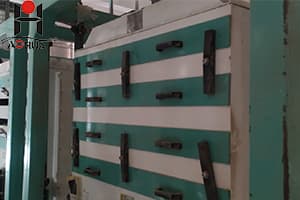- Whatsapp:+86-13949074923
- Email: AoHua@aohuascreeningmachine.com
Products list
inquery
Screening equipment
2022-02-11
Screening equipment
(1) Flat screen: It is the main screening equipment in flour mills. Because the screen surface is a horizontal device, and the entire screen body performs a plane rotary motion during operation, it is called a flat screen. Its main features are large sieving area and many types of grading. The screen shape of the flat screen is square and rectangular. At present, a high square screen with multiple square screen cells is commonly installed. The high square sieve adopts square sieve grids, and 16-24 layers of sieve grids are overlapped to form a higher sieve body.
(2) The sieve path of the flat sieve

The sieving process composed of multiple sieve grids according to certain rules is called .
1. Basis for formulating sieves
Factors such as the nature of the screening material, the type of classification, the type of flat screen, and the climate must be considered when formulating a flat screen sieve path to determine the order of extracting various WIPs and their respective required screening lengths.
2. Features of each system sieve
①Qianlu skin mill sieve: Among the ground materials of Qianlu skin mill, there are many kinds of products in process, the particle size and quality of bran, slag core and powder are greatly different, and the scattering and automatic classification are good, so there are many types of classification required. Generally, 5-7 kinds of materials are required to be separated for the powder-extraction method by the heart mill; Generally, 3-5 grids are used for the coarse sieve for extracting bran flakes, and the slag and coarse powder are extracted.
4-6 grids are used for the sieve, and 8-12 grids are required to extract the powder. Generally, the sieving sequence of first lifting the coarse material, then grading and sieving the powder is adopted.
②Middle and back road skin grinding and sieve road: In the middle and back road skin grinding materials, the grain size of bran flakes is smaller, the endosperm content is reduced, and the number of slag cores is reduced. Generally, it is only divided into 4-5 kinds of materials. The sieving length for separating each material is generally: 3-6 grids for large bran flakes, 6 grids for small bran chips, 4 grids for slag, and 8 grids for powder sieve. The sieve sequence is similar to the previous one.
3. Skin mill heavy screen sieve path: The material entering the heavy screen is the sieve of the skin mill powder sieve, which is the mixture of wheat heart, coarse powder and flour. The particle size and quality are relatively close, and the scattering and automatic classification are good. The sieve path of first sieving and then grading, or grading, sieving and then grading is adopted. The length of the grading sieve for each material is 5-6 grids, and the rest are powder sieves.
4. Screening path of the slag mill system: The material of the slag mill is the endosperm grains connected with the cortex, so the sieve path is mainly to separate a small amount of fine bran and flour, and bring out more fine slag and wheat core. For short, use 4 grids to separate fine bran, 4-6 grids to separate each kind of slag, and the rest are flour sieves.
5. The sieve path of the heart mill system: The particle size and quality of the heart mill are small, and the scatterability and automatic classification are poor. Except for a small amount of bran crumbs, all are pure wheat hearts, coarse powder and flour, so the heart mill system is mainly a powder sieve. Appropriate grading sieves can be configured for the front and middle road core mills to extract the bran crumbs in the materials and ensure the quality of the subsequent core mill materials. The sieve length of each classification is 4-5 grids. screen
The rationale sequence is as follows: the front-road coarse grinding can be graded first, then sieved and then classified; the front-road central grinding and the middle-road central grinding usually use the first sieving and then the grading; the back-road central grinding does not have grading, and all are powder sieves.
6. Flour inspection sieve: The purpose of the flour inspection sieve is to separate the bran crumbs and coarse inclusions mixed into the flour. More than 99% of the sieved material is flour, so there is no classification, and all are flour sieves, in order to make full use of Screening area, increase output, reduce the thickness of the material layer on the screen, and improve the screening efficiency, often using multiple inlet screens.